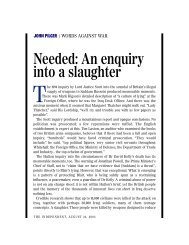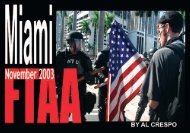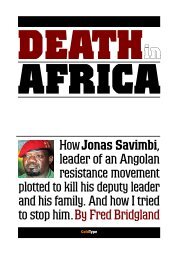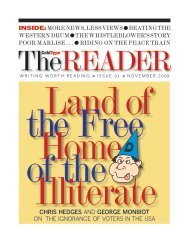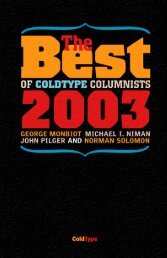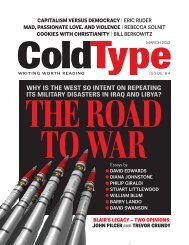UPDATED - ColdType
UPDATED - ColdType
UPDATED - ColdType
- TAGS
- updated
- coldtype
- coldtype.net
You also want an ePaper? Increase the reach of your titles
YUMPU automatically turns print PDFs into web optimized ePapers that Google loves.
War as staged spectacle<br />
ONE of the most dramatic stories of the war was<br />
a dramatic rescue of U.S. POW Jessica Lynch<br />
from an Iraqi hospital. It was covered for days as<br />
triumph for the U.S. military. A month after it<br />
occurred, The BBC took a second look. Its<br />
reporters found that the truth of what happened<br />
contradicted what seemed at the time like a<br />
Made for TV Movie (and yet may inspire one!).<br />
Reported Ellis Henican in Newsday: “Her rescue<br />
will go down as one of the most stunning<br />
pieces of news management yet conceived.” And<br />
John Kampfner, a British journalist who has<br />
taken a hard second look at the case for the BBC<br />
and the Guardian newspaper, concurs. His documentary,<br />
“Saving Private Jessica: Fact or Fiction?”<br />
aired in Britain on March l8.”<br />
Robert Scheer of the Los Angeles Times<br />
added: “Sadly, almost nothing fed to reporters<br />
about either Lynch’s original capture by Iraqi<br />
forces or her ‘rescue’ by U.S. forces turns out to<br />
be true. Consider the April 3 Washington Post<br />
story on her capture headlined ‘She Was Fighting<br />
to the Death,’ which reported, based on<br />
unnamed military sources, that Lynch ‘continued<br />
firing at the Iraqis even after she sustained<br />
multiple gunshot wounds,’ adding that she was<br />
also stabbed when Iraqi forces closed in.<br />
“It has since emerged that Lynch was neither<br />
shot nor stabbed, but rather suffered accident<br />
injuries when her vehicle overturned,” Scheer<br />
wrote. “A medical checkup by U.S. doctors confirmed<br />
the account of the Iraqi doctors, who said<br />
they had carefully tended her injuries, a broken<br />
arm and thigh and a dislocated ankle, in contrast<br />
to U.S. media reports that doctors had ignored<br />
Lynch,” he concluded. (Later, the claims in the<br />
INTRODUCTION<br />
22<br />
piece would be challenged as distorted by Geoffrey<br />
Sherwood on Asia Times: “Kampfner's<br />
analysis was flawed on several levels. If CENT-<br />
COM went to great lengths to manipulate the<br />
war reporting, as Kampfner alleges, then it failed<br />
miserably." This debate is likely to continue.)<br />
The war’s other “most dramatic moment” was<br />
the toppling of the statue of Saddam Hussein.<br />
Many media critics like Ted Rall debunked this<br />
story thoroughly. “The stirring image of Saddam’s<br />
statue being toppled on April 9th turns out<br />
to be fake, the product of a cheesy media op<br />
staged by the U.S. military for the benefit of cameramen<br />
staying across the street at Baghdad’s<br />
Palestine Hotel. This shouldn’t be a big surprise.<br />
Two of the most stirring photographs of World<br />
War II – the flag raising at Iwo Jima and General<br />
MacArthur’s stroll through the Filipino surf –<br />
were just as phony.”<br />
Competing narratives<br />
OUTSIDE the United States, there were competing<br />
narratives in the coverage of the war. Americans<br />
saw a different war than the one presented<br />
in the media in Europe and the Arab world.<br />
These differences raised “vexing questions” for<br />
media scholar Jacqueline E. Sharkey “about the<br />
responsibilities of the press in wartime, journalistic<br />
values such as objectivity, and the relationships<br />
among the press, the public and the government<br />
. . . During the war in Iraq, television<br />
news operations in Arab countries provided<br />
viewers throughout the world with an alternative<br />
view of the conflict, “ she wrote in the AJR.<br />
“Arabs and Muslims are getting a dramatically<br />
different narrative from their American counterparts,”<br />
says Fawaz Gerges, who holds a chair in



